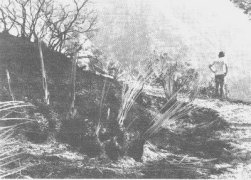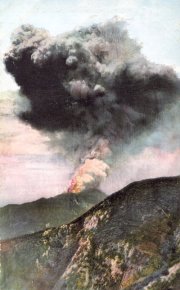
Altadena resident Daniel Macpherson, stands at Echo Mountain, surveying the extent of the 1979 fire. In the foreground are burnt yucca plants.
Return to Echo Mtn. Echoes, Winter 1999 Cover
| The Valley of Smokes |
Valley of Smokes
By Christopher Nyerges
 |
|
Altadena resident Daniel Macpherson, stands at Echo Mountain, surveying the extent of the 1979 fire. In the foreground are burnt yucca plants. |
In 1990, I was standing in the
parking area, which leads down into Switzer's Camp. A land-management expert and
I were standing there, talking, looking out over the sprawling terrain. My
friend told me that due to the abundance of dead wood and other accumulated
flammable material, the Angeles National forest was "ripe" for a
massive fire. There years later, I recalled that sobering forewarning when I
watched the firestorms rage through Southern California - including Eaton
Canyon, and other front-country areas of the Angeles National Forest.
I recall years earlier in 1979 when Daniel McPherson and I hiked up to Echo
Mountains a day after a fire "cleaned" the area. It was quite a sight.
Yucca plants appeared as blackened pineapples, and they still smoked. All the
underbrush was gone, and we could actually clearly see the outline of the old
buildings that once resided there. Charred blackness was everywhere, yet it
would be a matter of weeks before we had rains and a revival of the land.
The southern California chaparral regions - which include about three-quarters
of the Angeles national Forest - are similar to such eco-systems as the Great
Plains, the longleaf pine forests, the Australian "outback," and
numerous other habitats in that they all require fire. Fire is what made the
Great Plains. And fire is what germinates certain seeds that live in these
unique environments. Fire is what creates the conditions for rejuvenation and
allows various flora and fauna to thrive.
Let's turn back the clock for a moment. Before we all moved into this coastal
desert plain we call Southern California, various Amerindians (the Chumash, the
Gabrielinos, and others) lived here practicing what can be termed "land
management" or "passive agriculture." There were no farms, as we
know them. One feature of their land management was fire.
 |
|
Scene of a forest fire behind Mt. Lowe as depicted on a Mt. Lowe postcard. |
The San Gabriel Valley at the
base of the Angeles National forest was once a vast oak forest with a carpet of
grasses. Generally, fires would be set twice a year by the local Indians and
allowed to burn through the entire valley. The first fire of each season was
some time around April or May (before the rains were over). Its purpose was to
burn down the woody brush and tall grasses that resulted from the winter rains.
There were many beneficial results from these fires, such as fertilizing the
fields with ash, and allowing other more useful plants to grow.
The second fire would generally be in September, to clear the fields of whatever
was left of the season's wild herbs and greens, and burn out dry tinder and
fallen wood from the oaks and wild vines (such as grapes and blackberries). This
served as a "pruning:" for the food trees, which yielded better fruit
in greater quantity as a result. The fires also killed off the bulk of larvae
that feed on acorns, and hardened the ripening acorn shells so that they'd be
insect-resistant. In the old days, fire-hardened acorns might last up to 10
years with no insect infestation, whereas today they spoil in less than six
months. And once again, the season's second fires would leave fertilizer ash in
the fields. Since these were annual fires, the "damage" was minimal. A
grassfire moves quickly but if there is little fuel, it moves on.
Village sites were usually protected from the fires by their strategic
locations, and by the way the fires were set. Teams of workers would set a fire
and keep it confined to a specific area. These people who lived close to the
land were attuned to the weather and variables of the season, so they knew the
best and safest times to burn. Fire was literally the cleanser,
fertilizer-maker, and food-producer of the culture that inhabited this area
before the Spanish missionaries arrived.
The upper San Gabriel Valley was called "the valley of smokes"
precisely for this reason. That there is debate is understandable, given the
fact that "we" allow housing construction in the most vulnerable of
places. Homes go up in smoke, and tragically transform the sacred domicile into
smoldering ash. But fire is not the enemy. The "enemy" is our own
greed, our own blindness, and our own foolish stubbornness to attempt to fight
against and conquer nature, rather than to learn and to live by the principles
of nature. As Pogo said, "I have met the enemy and he is us."
In the spring of 1993, I learned a new bit of local Indian weather lore. When
the yuccas bloom in profusion, you can expect a great fire. Individual yuccas
may live anywhere from seven to 20years before flowering and dying. Some years
you see very little flowering in April and May. In the winter of 1992-93, we
experienced record rains, and the hills greened up, and the yuccas flowered in a
great majesty. I felt relief when September passed, since September is typically
the fire month. And with October nearly over, I heaved a great sigh that we'd
been spared this season's. I knew that with no annual fire, the threat is great,
and that this could be "the big one." And so came the Great Winds of
Santa Ana just about the time of the Samhain. And the ghastly, ghostly, hellish
firestorms rolled over the land. Yes, it was good for the chaparral to be
cleansed and renewed, but in its wake hundreds of families were driven from
their homes. And as it rolled over the land, fire knew no favorites.
In some eco-systems, which require fires, biologists have noted that certain
flora and fauna are becoming endangered due to the policy of fire suppression.
Our environment here is fire-dependent. Parochial "environmentalists"
and homeowners' groups have argued against controlled burns because they claim
such burns kill animals. In fact, the fires usually take very few lives because
they are generally of such a low intensity. In balance, the fire must be viewed
as beneficial since it kills off bacteria harmful to trees, kills mainly sick
and diseased animals, and limits the outbreak of plague and other diseases. Once
burned and renewed, the flora and fauna rise up again Phoenix-like to repeat the
cycle.
In the Altadena fires of 1993, many of the wildlife simply moved out of the way
for a while. A week after the Altadena fire, I was camped out in the extreme
north end of a canyon to the west. Animals were abundant - you'd think it was a
wildlife sanctuary. Animals were stirred up as new competitors moved into their
territory. Many birds made their presence known during the day, and at night we
heard gray squirrels, raccoons, and owls, each making their unique calls. We
can't go back to old days and burn down Pasadena every year. The valleys are no
longer oak forests filled with grass floors. They are square lots criss-crossed
with cement rivers. The old days are over. So what can we do? Buildings simply
shouldn't be allowed in the high-risk areas. And any homes bordering on
chaparral can be surrounded with non-flammable vegetation such as walls of
prickly pear cactus, which stop fire in all but the worst firestorms. Wood
shingle roofs should be outlawed. And controlled burns - yes, we should have
controlled burns, a little here, a little there, done during the cool days of
winter or early spring. Without controlled burns, the fuel in the forest builds
up and large-scale fire catastrophes will be inevitable every few decades.
Fire is not our enemy, nor is Wind our enemy, nor is Water, nor is the
Earth-that-Quakes. More often than not, when we point our finger at these Forces
of Nature and call them "bad," we choose to ignore our own culpability
directly or indirectly that led to a situation out of control. We either learn
the principles that each environment teaches us, and abide by those principles,
or we don't. If we don't (and we haven't been doing very well in this
department) then truly, we are our own worst enemy.
Since 1974, Nyerges has been conducting field trips to teach how to identify edible wild plants, and learn about the survival skills of the past. He is the author of Enter the Forest and Guide to Wild Foods, which contain information about the ways of the Gabrielinos in the past. Both books are available in the Echo Mtn. Echoe’s Mountain Marketplace. For a schedule of his classes, contact him at School of Self-Reliance, Box 41834, Eagle Rock, CA 90041, or on-line at www.self-reliance.net.
Return to Echo Mtn. Echoes, Winter 1999 Cover
[ Issues | Search | Help | Subscribe | Comment | Websites ]
Send email to Echowebmaster@aaaim.com to report any problems.
Last modified: February 12, 1999
No part of this paper may be
reproduced in any form without written permission from:
Jake Brouwer
All articles and photos were provided by:
Land-Sea Discovery Group
Copyright © 1999